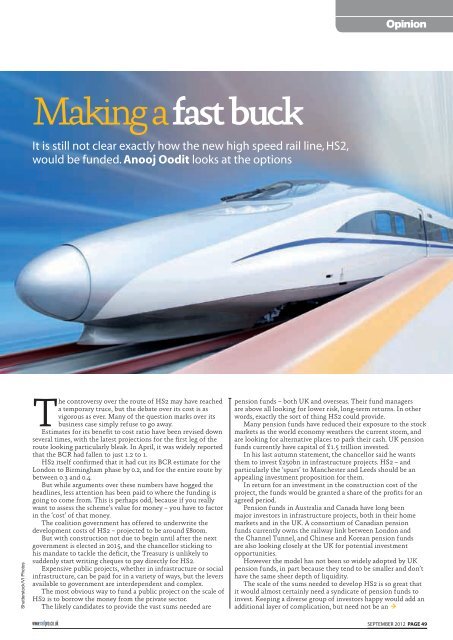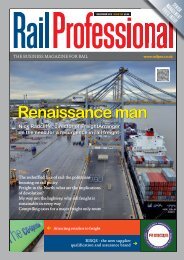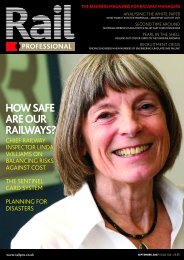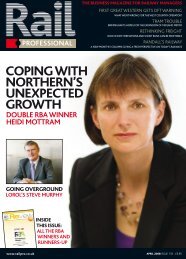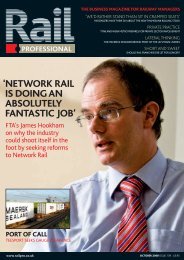View as PDF - Rail Professional
View as PDF - Rail Professional
View as PDF - Rail Professional
Create successful ePaper yourself
Turn your PDF publications into a flip-book with our unique Google optimized e-Paper software.
Opinion<br />
Making a f<strong>as</strong>t buck<br />
It is still not clear exactly how the new high speed rail line, HS2,<br />
would be funded. Anooj Oodit looks at the options<br />
Shutterstock/VI Photos<br />
The controversy over the route of HS2 may have reached<br />
a temporary truce, but the debate over its cost is <strong>as</strong><br />
vigorous <strong>as</strong> ever. Many of the question marks over its<br />
business c<strong>as</strong>e simply refuse to go away.<br />
Estimates for its benefit to cost ratio have been revised down<br />
several times, with the latest projections for the first leg of the<br />
route looking particularly bleak. In April, it w<strong>as</strong> widely reported<br />
that the BCR had fallen to just 1.2 to 1.<br />
HS2 itself confirmed that it had cut its BCR estimate for the<br />
London to Birmingham ph<strong>as</strong>e by 0.2, and for the entire route by<br />
between 0.3 and 0.4.<br />
But while arguments over these numbers have hogged the<br />
headlines, less attention h<strong>as</strong> been paid to where the funding is<br />
going to come from. This is perhaps odd, because if you really<br />
want to <strong>as</strong>sess the scheme’s value for money – you have to factor<br />
in the ‘cost’ of that money.<br />
The coalition government h<strong>as</strong> offered to underwrite the<br />
development costs of HS2 – projected to be around £800m.<br />
But with construction not due to begin until after the next<br />
government is elected in 2015, and the chancellor sticking to<br />
his mandate to tackle the deficit, the Tre<strong>as</strong>ury is unlikely to<br />
suddenly start writing cheques to pay directly for HS2.<br />
Expensive public projects, whether in infr<strong>as</strong>tructure or social<br />
infr<strong>as</strong>tructure, can be paid for in a variety of ways, but the levers<br />
available to government are interdependent and complex.<br />
The most obvious way to fund a public project on the scale of<br />
HS2 is to borrow the money from the private sector.<br />
The likely candidates to provide the v<strong>as</strong>t sums needed are<br />
pension funds – both UK and overse<strong>as</strong>. Their fund managers<br />
are above all looking for lower risk, long-term returns. In other<br />
words, exactly the sort of thing HS2 could provide.<br />
Many pension funds have reduced their exposure to the stock<br />
markets <strong>as</strong> the world economy weathers the current storm, and<br />
are looking for alternative places to park their c<strong>as</strong>h. UK pension<br />
funds currently have capital of £1.5 trillion invested.<br />
In his l<strong>as</strong>t autumn statement, the chancellor said he wants<br />
them to invest £250bn in infr<strong>as</strong>tructure projects. HS2 – and<br />
particularly the ‘spurs’ to Manchester and Leeds should be an<br />
appealing investment proposition for them.<br />
In return for an investment in the construction cost of the<br />
project, the funds would be granted a share of the profits for an<br />
agreed period.<br />
Pension funds in Australia and Canada have long been<br />
major investors in infr<strong>as</strong>tructure projects, both in their home<br />
markets and in the UK. A consortium of Canadian pension<br />
funds currently owns the railway link between London and<br />
the Channel Tunnel, and Chinese and Korean pension funds<br />
are also looking closely at the UK for potential investment<br />
opportunities.<br />
However the model h<strong>as</strong> not been so widely adopted by UK<br />
pension funds, in part because they tend to be smaller and don’t<br />
have the same sheer depth of liquidity.<br />
The scale of the sums needed to develop HS2 is so great that<br />
it would almost certainly need a syndicate of pension funds to<br />
invest. Keeping a diverse group of investors happy would add an<br />
additional layer of complication, but need not be an<br />
SEPTEMBER 2012 Page 49


